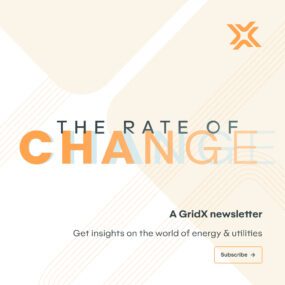Expert Insights: What to Consider to Increase Adoption of TOU Rates


When implementing and driving adoption of time-of-use (TOU) and other modern rate designs, it’s important to personalize the message for each customer, keep communication flowing, and remember you don’t always have to launch a pilot program before your TOU rollout.
Modern rate designs are critical to managing the increasingly complex electric grid, integrating distributed energy resources (DER), and achieving decarbonization targets. Yet, according to the U.S. Energy Information Administration, while TOU rates are available to 62% of U.S. residential customers, only 7.3% are enrolled in these types of plans.
Eva Molnar of Southern California Edison (SCE), Sanem Sergici of The Brattle Group, and GridX’s Scott Engstrom recently sat down to discuss how we can bridge this gap and increase adoption of TOU rates as part of a live forum with Canary Media.
Three actionable considerations emerged that can help any electric utility increase adoption of TOU rates and ensure a positive customer experience.
1. Personalize the message and let people know exactly what they can expect to pay
Energy customers need to have confidence they are making the right decisions and won’t be financially punished for their usage. But every customer is different. Do they have solar? Do they charge an electric vehicle (EV)? Are they still working from home on weekdays during critical peak hours? These are all critical factors in determining the optimal rate plan.
People are more likely to switch to a TOU rate structure – and succeed on it – when they know what they can expect to pay. Educating customers with accurate, clear, and transparent data about the impacts of their electricity use is important to increasing customer adoption.
Rising energy costs are at the forefront of many utility customers’ minds, especially middle or low-income customers. While global concern over emissions and climate change is rising, the key incentive for many customers to switch to TOU pricing will be the financial benefits. According to renewable energy statistics, 21.5% of energy in the U.S. is generated from renewable sources like solar and wind. A TOU rate can lead to significant savings for customers who use DERs like solar panels, a wind generator, or battery storage.
Environmental concerns are driving the conversation about renewable energy sources, clean energy, smart meters that supply real-time data, smart thermostats that adjust temperature settings for best performance, and other demand response techniques. However, for many customers, changing their energy consumption behavior — like shifting the time of day they use energy to off-peak periods — will require a lifestyle adjustment.
Energy providers must remember that strong opt-in numbers and customer satisfaction will depend on how the energy bill improves for each customer individually.
Online comparison tools can be helpful, such as the one SCE used, which led to some great results! They can clarify bill impacts and help customers understand how load shifting energy use to off-peak hours rather than times of peak demand will translate to bill savings.
When SCE started their default pilot in March 2018, only 12% of the 400,000 customers opted out of the TOU electricity rates prior to the transition. Since then, only 2% have switched back to the tiered rate.
The rate comparison tool also led to increased customer awareness and satisfaction. Specifically, they saw a 400% increase in customers using the tool. And among those who say they are on a time-of-use rate, the proportion who believe it is the best rate option for them increased significantly from 66% to 82% in fall 2019.
2. Keep communication flowing
In the pre-enrollment phase, emphasize education. TOU rates are a new concept that the average energy user may struggle to understand. And if they sign up for a different rate plan without grasping the required change to their energy usage behavior, higher energy bills are all but guaranteed.
If electricity usage isn’t reduced during peak load hours, peak pricing can lead to significant increases in customer bills.
So, be transparent and make sure your customers understand the process. Use community outreach to inform and educate. Get out in front of the more frequently raised concerns, like defining what on-peak and off-peak times are, explaining energy efficiency and reliability impacts of their behavior, and showing people exactly what they can expect to pay on their new rate.
With this pre-enrollment foundation set, be sure to continuously communicate through the enrollment and post-enrollment phases of the implementation.
Be available, anticipate customer pain points and have readily available resources for them to access. Your customer service or call center should be thoroughly trained and ready to answer questions and walk customers through the pricing of the rate they are on, their electricity bills, and helpful tips for managing energy consumption.
3. Don’t assume you have to pilot your new rate program
Running a pilot is a great way to see how a program will perform before a broad rollout.
SCE ran two pilots – one for an opt-in program in 2016 and another for its default offering in 2018. Those pilots helped SCE learn a lot about the communications that resonated with customers, the proper cadence of that messaging, and whether there were any operational kinks to work out. The insights gleaned from these efforts contributed to the success of the full-scale implementation.
But that doesn’t mean a pilot is necessary in every case. It should be noted that these SCE “pilots” were targeted at 100K and 200K customers, respectively. Those can’t be considered small by any means! They really were a true test of how the TOU rates would perform within a large population.
For example, Pacific Gas and Electric has been mandated by state regulators to enroll 2.5 million customers to a TOU rate plan in a gradual rollout. The new plan reduces peak load on power plants, but electricity prices are higher for customers in late afternoons and early evenings on weekdays. The switch was automatic, and in the first six months of the program only 17% of PG&E’s general customers opted out.
Ask the question, “Is there value in running a small pilot or should I just go for it?” For instance, research has consistently shown the value of opt-in pilots. So, reconsider running a 5-10K person pilot over the course of a year or two, at which point you need to have your commission approve it all over again. Trust the research and offer it to as many people as possible. Now is the time to get more people on TOU rates, not take a cautious approach.
Final thoughts on how to increase adoption of TOU rates
The bottom line…transparency, ongoing communication, and personalized data insights are imperative in implementing and ensuring TOU rate adoption. There was so much other good information in the live discussion with SCE and The Brattle Group. Check out the full video here. It’s worth your time.
If you have particular questions about implementing modern rate structures, we’d love to talk.

The 4 Universal Truths of a Successful TOU Rate Transition
Having been part of the most successful TOU implementations, we’ve learned a few best practices worth sharing.




